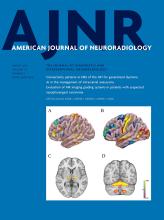Review ArticleAdult Brain
Open Access
Artificial Intelligence in the Management of Intracranial Aneurysms: Current Status and Future Perspectives
Z. Shi, B. Hu, U.J. Schoepf, R.H. Savage, D.M. Dargis, C.W. Pan, X.L. Li, Q.Q. Ni, G.M. Lu and L.J. Zhang
American Journal of Neuroradiology March 2020, 41 (3) 373-379; DOI: https://doi.org/10.3174/ajnr.A6468
Z. Shi
aFrom the Department of Medical Imaging (Z.S., B.H., Q.Q.N., G.M.L., L.J.Z.), Jinling Hospital, Medical School of Nanjing University, Nanjing, Jiangsu, China
B. Hu
aFrom the Department of Medical Imaging (Z.S., B.H., Q.Q.N., G.M.L., L.J.Z.), Jinling Hospital, Medical School of Nanjing University, Nanjing, Jiangsu, China
U.J. Schoepf
bDivision of Cardiovascular Imaging (U.J.S., R.H.S., D.M.D.), Department of Radiology and Radiological Science, Medical University of South Carolina, Charleston, South Carolina
R.H. Savage
bDivision of Cardiovascular Imaging (U.J.S., R.H.S., D.M.D.), Department of Radiology and Radiological Science, Medical University of South Carolina, Charleston, South Carolina
D.M. Dargis
bDivision of Cardiovascular Imaging (U.J.S., R.H.S., D.M.D.), Department of Radiology and Radiological Science, Medical University of South Carolina, Charleston, South Carolina
C.W. Pan
cDeepWise AI Lab (C.W.P., X.L.L.), Beijing, China
X.L. Li
cDeepWise AI Lab (C.W.P., X.L.L.), Beijing, China
dPeng Cheng Laboratory (X.L.L.), Vanke Cloud City Phase I, Nanshan District, Shenzhen, Guangdong, China.
Q.Q. Ni
aFrom the Department of Medical Imaging (Z.S., B.H., Q.Q.N., G.M.L., L.J.Z.), Jinling Hospital, Medical School of Nanjing University, Nanjing, Jiangsu, China
G.M. Lu
aFrom the Department of Medical Imaging (Z.S., B.H., Q.Q.N., G.M.L., L.J.Z.), Jinling Hospital, Medical School of Nanjing University, Nanjing, Jiangsu, China
L.J. Zhang
aFrom the Department of Medical Imaging (Z.S., B.H., Q.Q.N., G.M.L., L.J.Z.), Jinling Hospital, Medical School of Nanjing University, Nanjing, Jiangsu, China

References
- 1.↵
- Vlak MH,
- Algra A,
- Brandenburg R, et al
- 2.↵
- 3.↵
- Boland GW,
- Guimaraes AS,
- Mueller PR
- 4.↵
- 5.↵
- Morita A,
- Kirino T,
- Hashi K, et al
- 6.↵
- Naggara ON,
- Lecler A,
- Oppenheim C, et al
- 7.↵
- 8.↵
- Zhou ZH
- 9.↵
- 10.↵
- Dey D,
- Slomka PJ,
- Leeson P, et al
- 11.↵
- 12.↵
- Varble N,
- Tutino VM,
- Yu J, et al
- 13.↵
- 14.↵
- 15.↵
- 16.↵
- 17.↵
- 18.↵
- 19.↵
- Hirai T,
- Korogi Y,
- Arimura H, et al
- 20.↵
- 21.↵
- 22.↵
- 23.↵
- 24.↵
- Sichtermann T,
- Faron A,
- Sijben R, et al
- 25.↵
- 26.↵
- 27.↵
- Miki S,
- Hayashi N,
- Masutani Y, et al
- 28.↵
- 29.↵
- Suh SH,
- Cloft HJ,
- Huston J, et al
- 30.↵
- 31.↵
- 32.↵
- 33.↵
- 34.↵
- 35.↵
- 36.↵
- 37.↵
- Cebral JR,
- Vazquez M,
- Sforza DM, et al
- 38.↵
- 39.↵
- 40.↵
- 41.↵
- 42.↵
- Dumont TM,
- Rughani AI,
- Tranmer BI
- 43.↵
- Adams HP Jr.,
- Kassell NF,
- Torner JC, et al
- 44.↵
- Qureshi AI,
- Sung GY,
- Razumovsky AY, et al
- 45.↵
- 46.↵
- Ramos LA,
- van der Steen WE,
- Sales Barros R, et al
- 47.↵
- 48.↵
- 49.↵
- Brinjikji W,
- Murad MH,
- Lanzino G, et al
- 50.↵
- 51.↵
- 52.↵
- 53.↵
- 54.↵
- 55.↵
In this issue
American Journal of Neuroradiology
Vol. 41, Issue 3
1 Mar 2020
Advertisement
Z. Shi, B. Hu, U.J. Schoepf, R.H. Savage, D.M. Dargis, C.W. Pan, X.L. Li, Q.Q. Ni, G.M. Lu, L.J. Zhang
Artificial Intelligence in the Management of Intracranial Aneurysms: Current Status and Future Perspectives
American Journal of Neuroradiology Mar 2020, 41 (3) 373-379; DOI: 10.3174/ajnr.A6468
0 Responses
Jump to section
Related Articles
Cited By...
- Comprehensive imaging analysis of intracranial atherosclerosis
- Deep geometric learning for intracranial aneurysm detection: towards expert rater performance
- Artificial Intelligence and Machine Learning in Aneurysmal Subarachnoid Hemorrhage: Future Promises, Perils, and Practicalities
- Rupture risk prediction of cerebral aneurysms using a novel convolutional neural network-based deep learning model
- Detection of clustered anomalies in single-voxel morphometry as a rapid automated method for identifying intracranial aneurysms
This article has not yet been cited by articles in journals that are participating in Crossref Cited-by Linking.
More in this TOC Section
Similar Articles
Advertisement











